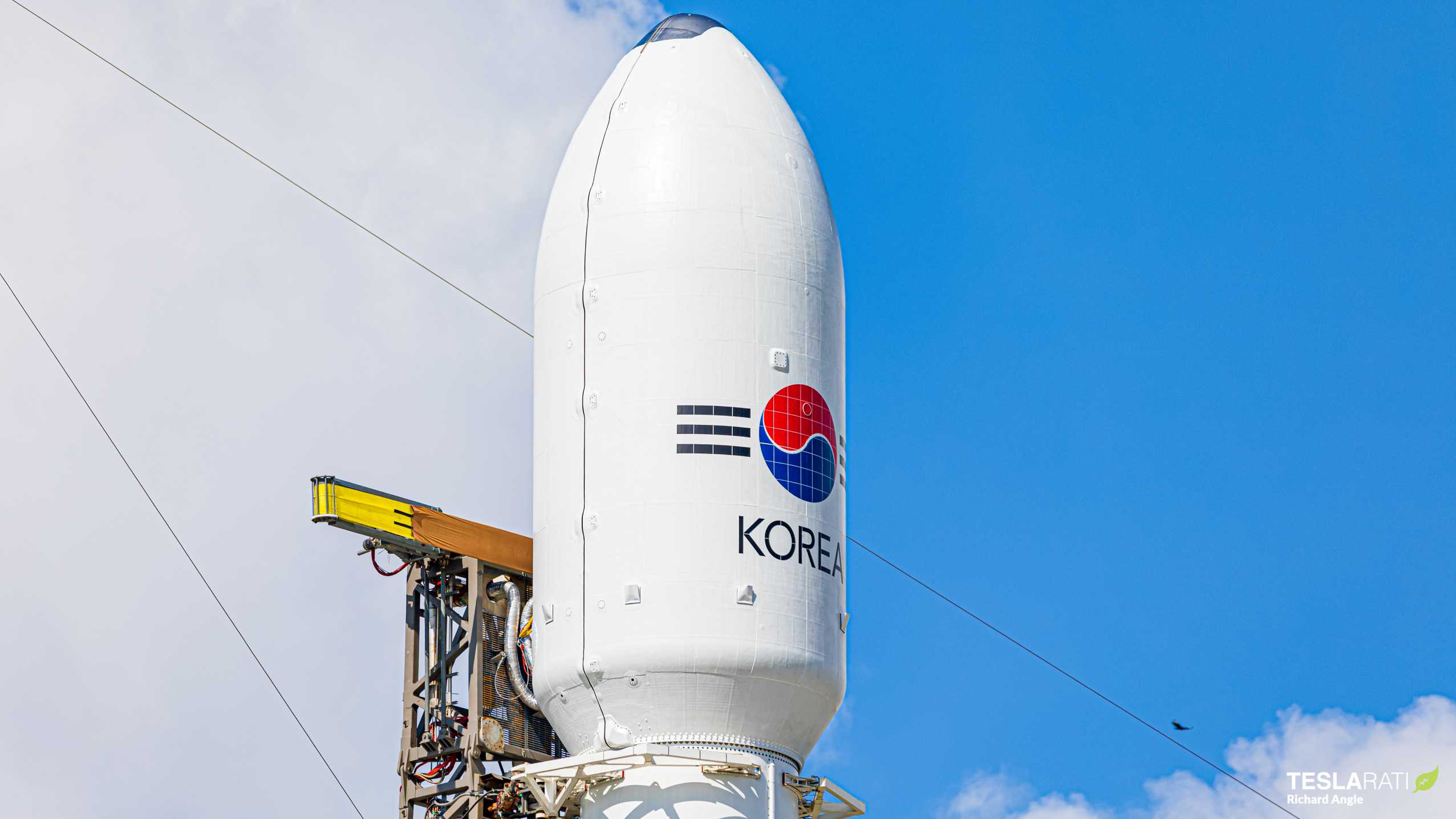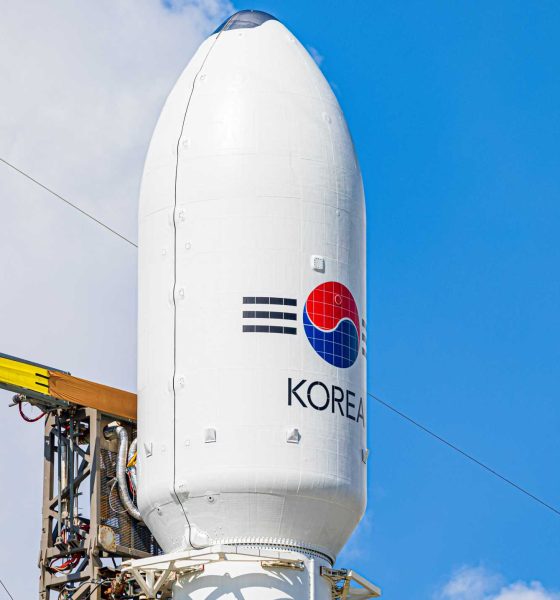

News
SpaceX to launch five South Korean military satellites by 2025
South Korea is deepening its relationship with SpaceX with a contract to launch at least five military reconnaissance satellites on Falcon 9 rockets by the end of 2025.
Known as the “425 Project,” South Korea intends to operate its own small constellation of five new Earth observation satellites: four synthetic aperture radar (SAR) satellites and one electro-optical infrared (EO/IR) satellite. All five would help ensure the near-continuous observation of sites of interest in North Korea, nominally allowing for new observations to be made at least every two hours. In a boon to South Korea’s aerospace industry, the country intends to domestically design and manufacture most or all aspects of those spacecraft. Developing domestic aerospace solutions has been a significant industrial priority for the country in recent years.
As a result, South Korea’s first stab at a domestic satellite constellation probably won’t produce record-breaking results. Publicly, the goal is to develop satellites with a maximum resolution of 0.3-0.5 meters (1-1.6 ft) per pixel – similar to the publicly established capabilities of most modern mid-sized Earth observation satellites. However, the classified capabilities of the US military and US spy agencies may offer several times that resolving power. South Korea is a close ally of the United States and likely benefits significantly from shared US intelligence. But it’s still no surprise that a country with such a belligerent neighbor would want to own and operate its own fleet of reconnaissance satellites and have the ability to independently produce its own spacecraft.
On top of working on those spacecraft, South Korea has also been developing a fully domestic orbital launch capability. The Korea Aerospace Research Institute (KARI) attempted to launch the first fully completed Korean Satellite Launch Vehicle II (KSLV-2) – also known as Nuri – in October 2021 but fell just short of orbit after its first and second stages performed nominally but its third stage ran into pressurization issues. Nuri is scheduled to return to flight as early as June 15th, 2022. Once operational, the South Korean rocket is designed to launch up to 2.6 tons (~5700 lb) to low Earth orbit (LEO) and 1.5 tons (~3300 lb) to a slightly higher sun-synchronous orbit (SSO).
South Korea’s decision to manifest its 425 Project satellites on SpaceX rockets thus raises some questions about South Korea’s confidence in – or plans to use – its own homegrown launch capabilities. Assuming Nuri more or less meets its performance goals and successfully reaches orbit during its second launch attempt in mid-2022, both of which seem plausible, the rocket would likely be more than capable of beginning operational launches no later than 2023. In fact, South Korea says that its EO/IR satellite – scheduled to launch first – will weigh around 800 kilograms (~1750 lb), making it a near-perfect fit for Nuri’s first operational launch. Such a small payload would give the rocket a large safety margin to account for any unexpected performance losses.
Instead, South Korea has decided to launch all five spacecraft on SpaceX rockets. SpaceX already has a solid relationship with the country: the company recently launched its Lockheed Martin-built ANASIS-II military communications satellite and is scheduled to launch KARI’s Korean Pathfinder Lunar Orbiter (KPLO) – South Korea’s first mission beyond Earth orbit – no earlier than August 2022.
It’s unclear if SpaceX will launch South Korea’s ‘425’ satellites individually on dedicated Falcon 9s, as rideshare payloads alongside other paying customers, or – in the case of the four SAR satellites – in batches of two or four. KPLO will be a Falcon 9 rideshare payload, making it clear that South Korea is happy to exploit cost-effective rideshare launches – though that calculus may change for military payloads. Regardless, South Korea’s latest contract won’t hurt SpaceX’s commercial manifest, which currently includes around 75 publicly-acknowledged Falcon launches.

News
Tesla Model Y Standard Long Range RWD launches in Europe
The update was announced by Tesla Europe & Middle East in a post on its official social media account on X.

Tesla has expanded the Model Y lineup in Europe with the introduction of the Standard Long Range RWD variant, which offers an impressive 657 km of WLTP range.
The update was announced by Tesla Europe & Middle East in a post on its official social media account on X.
Model Y Standard Long Range RWD Details
Tesla Europe & Middle East highlighted some of the Model Y Standard Long Range RWD’s most notable specs, from its 657 km of WLTP range to its 2,118 liters of cargo volume. More importantly, Tesla also noted that the newly released variant only consumes 12.7 kWh per 100 km, making it the most efficient Model Y to date.
The Model Y Standard provides a lower entry point for consumers who wish to enter the Tesla ecosystem at the lowest possible price. While the Model 3 Standard is still more affordable, some consumers might prefer the Model Y Standard due to its larger size and crossover form factor. The fact that the Model Y Standard is equipped with Tesla’s AI4 computer also makes it ready for FSD’s eventual rollout to the region.
Top Gear’s Model Y Standard review
Top Gear‘s recent review of the Tesla Model Y Standard highlighted some of the vehicle’s most notable features, such as its impressive real-world range, stellar infotainment system, and spacious interior. As per the publication, the Model Y Standard still retains a lot of what makes Tesla’s vehicles well-rounded, even if it’s been equipped with a simplified interior.
Top Gear compared the Model Y Standard to its rivals in the same segment. “The introduction of the Standard trim brings the Model Y in line with the entry price of most of its closest competition. In fact, it’s actually cheaper than a Peugeot e-3008 and costs £5k less than an entry-level Audi Q4 e-tron. It also makes the Ford Mustang Mach-E look a little short with its higher entry price and worse range,” the publication wrote.
Elon Musk
Elon Musk’s xAI bets $20B on Mississippi with 2GW AI data center project
The project is expected to create hundreds of permanent jobs, dramatically expand xAI’s computing capacity, and further cement the Mid-South as a growing hub for AI infrastructure.

Elon Musk’s xAI plans to pour more than $20 billion into a massive new data center campus in Southaven, Mississippi, marking the largest single economic development project in the state’s history.
The project is expected to create hundreds of permanent jobs, dramatically expand xAI’s computing capacity, and further cement the Mid-South as a growing hub for AI infrastructure.
xAI goes MACROHARDRR in Mississippi
xAI has acquired and is retrofitting an existing facility in Southaven to serve as a new data center, which will be known as “MACROHARDRR.” The site sits near a recently acquired power plant and close to one of xAI’s existing data centers in Tennessee, creating a regional cluster designed to support large-scale AI training and inference.
Once completed, the Southaven facility is expected to push the company’s total computing capacity to nearly 2 GW, placing it among the most powerful AI compute installations globally. The data center is scheduled to begin operations in February 2026.
Gov. Tate Reeves shared his optimism about the project in a press release. “This record-shattering $20 billion investment is an amazing start to what is sure to be another incredible year for economic development in Mississippi. Today, Elon Musk is bringing xAI to DeSoto County, a project that will transform the region and bring amazing opportunities to its residents for generations. This is the largest economic development project in Mississippi’s history,” he said.
xAI’s broader AI ambitions
To secure the investment, the Mississippi Development Authority approved xAI for its Data Center Incentive program, which provides sales and use tax exemptions on eligible computing hardware and software. The City of Southaven and DeSoto County are also supporting the project through fee-in-lieu agreements aimed at accelerating development timelines and reducing upfront costs.
Founded in 2023 by Elon Musk, xAI develops advanced artificial intelligence systems focused on large-scale reasoning and generative applications. Its flagship product, Grok, is integrated with the social media platform X, alongside a growing suite of APIs for image generation, voice, and autonomous agents, including offerings tailored for government use.
Elon Musk highlighted xAi’s growth and momentum in a comment about the matter. “xAI is scaling at an immeasurable pace — we are building our third massive data center in the greater Memphis area. MACROHARDRR pushes our Colossus training compute to ~2GW – by far the most powerful AI system on Earth. This is insane execution speed by xAI and the state of Mississippi. We are grateful to Governor Reeves for his support of building xAI at warp speed,” Musk said.
Elon Musk
Tesla AI Head says future FSD feature has already partially shipped

Tesla’s Head of AI, Ashok Elluswamy, says that something that was expected with version 14.3 of the company’s Full Self-Driving platform has already partially shipped with the current build of version 14.2.
Tesla and CEO Elon Musk have teased on several occasions that reasoning will be a big piece of future Full Self-Driving builds, helping bring forth the “sentient” narrative that the company has pushed for these more advanced FSD versions.
Back in October on the Q3 Earnings Call, Musk said:
“With reasoning, it’s literally going to think about which parking spot to pick. It’ll drop you off at the entrance of the store, then go find a parking spot. It’s going to spot empty spots much better than a human. It’s going to use reasoning to solve things.”
Musk said in the same month:
“By v14.3, your car will feel like it is sentient.”
Amazingly, Tesla Full Self-Driving v14.2.2.2, which is the most recent iteration released, is very close to this sentient feeling. However, there are more things that need to be improved, and logic appears to be in the future plans to help with decision-making in general, alongside other refinements and features.
On Thursday evening, Elluswamy revealed that some of the reasoning features have already been rolled out, confirming that it has been added to navigation route changes during construction, as well as with parking options.
He added that “more and more reasoning will ship in Q1.”
🚨 Tesla’s Ashok Elluswamy reveals Nav decisions when encountering construction and parking options contain “some elements of reasoning”
More uses of reasoning will be shipped later this quarter, a big tidbit of info as we wait v14.3 https://t.co/jty8llgsKM
— TESLARATI (@Teslarati) January 9, 2026
Interestingly, parking improvements were hinted at being added in the initial rollout of v14.2 several months ago. These had not rolled out to vehicles quite yet, as they were listed under the future improvements portion of the release notes, but it appears things have already started to make their way to cars in a limited fashion.
Tesla Full Self-Driving v14.2 – Full Review, the Good and the Bad
As reasoning is more involved in more of the Full Self-Driving suite, it is likely we will see cars make better decisions in terms of routing and navigation, which is a big complaint of many owners (including me).
Additionally, the operation as a whole should be smoother and more comfortable to owners, which is hard to believe considering how good it is already. Nevertheless, there are absolutely improvements that need to be made before Tesla can introduce completely unsupervised FSD.








